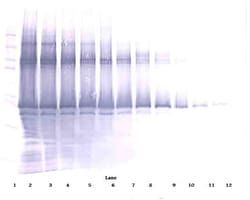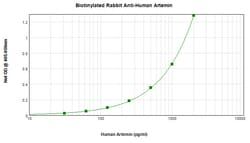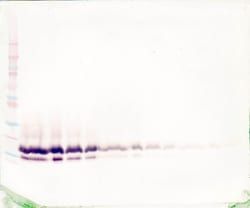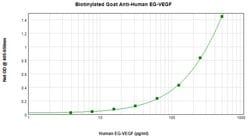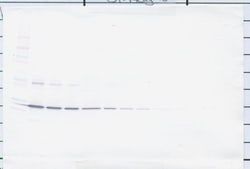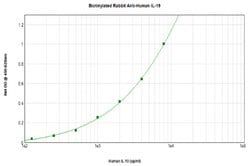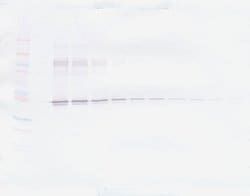7245355
Nanog Polyclonal Antibody, Biotin, PeproTech®, Invitrogen™
Rabbit Polyclonal Antibody
Manufacturer: Fischer Scientific
The price for this product is unavailable. Please request a quote
Antigen
Nanog
Applications
ELISA, Western Blot
Conjugate
Biotin
Host Species
Rabbit
Target Species
Human
Gene Accession No.
Q9H9S0
Gene ID (Entrez)
79923
Immunogen
E.coli-derived, 34.5 kDa Recombinant Human Nanog
Purification Method
Antigen affinity chromatography
Gene
NANOG
Concentration
0.1-1.0 mg/mL
Classification
Polyclonal
Form
Lyophilized
Regulatory Status
RUO
Formulation
PBS with no preservative
Gene Alias
2410002E02Rik; early embryo specific expression NK family; early embryo specific expression NK-type homeobox protein; Ecat4; ENK; ES cell-associated protein 4; FLJ12581; HGNC:20857; hNanog; Homeobox protein NANOG; homeobox transcription factor Nanog; homeobox transcription factor Nanog-delta 48; Nanog; Nanog homeobox
Gene Symbols
NANOG
Primary or Secondary
Primary
Content And Storage
-20°C
Description
- AA Sequence of recombinant protein: SVDPACPQSL PCFEASDCKE SSPMPVICGP EENYPSLQMS SAEMPHTETV SPLPSSMDLL IQDSPDSSTS PKGKQPTSAE NSVAKKEDKV PVKKQKTRTV FSSTQLCVLN DRFQRQKYLS LQQMQELSNI LNLSYKQVKT WFQNQRMKSK RWQKNNWPKN SNGVTQKASA PTYPSLYSSY HQGCLVNPTG NLPMWSNQTW NNSTWSNQTQ NIQSWSNHSW NTQTWCTQSW NNQAWNSPFY NCGEESLQSC MQFQPNSPAS DLEAALEAAG EGLNVIQQTT RYFSTPQTMD LFLNYSMNMQ PEDV
- Preparation: Produced from sera of rabbits immunized with highly pure Recombinant Human Nanog
- Anti-Human Nanog-specific antibody was purified by affinity chromatography and then biotinylated
- Sandwich ELISA: To detect hNanog by sandwich ELISA (using 100 μL/well antibody solution) a concentration of 0.25-1.0 μg/mL of this antibody is required
- This biotinylated polyclonal antibody, in conjunction with PeproTech Polyclonal Anti-Human Nanog (500-P236) as a capture antibody, allows the detection of at least 0.2-0.4 ng/well of Recombinant hNanog
- Western Blot: To detect hNanog by Western Blot analysis this antibody can be used at a concentration of 0.1-0.2 μg/mL
- Used in conjunction with compatible secondary reagents the detection limit for Recombinant hNanog is 1.5-3.0 ng/lane, under either reducing or non-reducing conditions
- 500-P236BT-1MG will be provided as 2 x 500 μg NANOG (Nanog homeobox) is a divergent homeodomain protein that directs pluripotency and differentiation of undifferentiated embryonic stem cells
- NANOG mRNA is present in pluripotent mouse and human cell lines, and absent from differentiated cells
- Human NANOG protein shares 52% overall amino acid identity with the mouse protein, and 85% identity in the homeodomain
- Human NANOG maps to gene locus 12p13.31, while the mouse NANOG maps to gene loci 6 F2
- Murine embryonic NANOG expression is detected in the inner cell mass of the blastocyst
- Research studies have shown that high levels of human NANOG expression in the undifferentiated N-Tera embryonal carcinoma cell line
- Further, NANOG is a transcription regulator involved in inner cell mass and embryonic stem (ES) cells proliferation and self-renewal
- The role of NANOG in embryonic development suggested that it might be useful in the creation of stem cells that might be useful in cell replacement therapies in the treatment of several degenerative diseases
- Artificial stem cells, termed induced pluripotent stem (iPS) cells, can be created by expressing POU5F1 (also known as Oct-4), another germline-specific transcription factor, and the transcription factors Sox2, Klf4 and Lin28 along with c-Myc in mouse fibroblasts
- Experiments have demonstrated that iPS cells could be generated using expression plasmids expressing NANOG, Sox2, KlfF4 and c-Myc, eliminating the need for virus introduction, thereby addressing a safety concern for potential use of iPS cells in regenerative medicine
- When overexpressed, NANOG promotes cells to enter into S phase and proliferation
- Diseases associated with dysfunction in the NANOG protein include tetracarcinoma and germ cell/embryonal cancer.
Compare Similar Items
Show Difference
Antigen: Nanog
Applications: ELISA, Western Blot
Conjugate: Biotin
Host Species: Rabbit
Target Species: Human
Gene Accession No.: Q9H9S0
Gene ID (Entrez): 79923
Immunogen: E.coli-derived, 34.5 kDa Recombinant Human Nanog
Purification Method: Antigen affinity chromatography
Gene: NANOG
Concentration: 0.1-1.0 mg/mL
Classification: Polyclonal
Form: Lyophilized
Regulatory Status: RUO
Formulation: PBS with no preservative
Gene Alias: 2410002E02Rik; early embryo specific expression NK family; early embryo specific expression NK-type homeobox protein; Ecat4; ENK; ES cell-associated protein 4; FLJ12581; HGNC:20857; hNanog; Homeobox protein NANOG; homeobox transcription factor Nanog; homeobox transcription factor Nanog-delta 48; Nanog; Nanog homeobox
Gene Symbols: NANOG
Primary or Secondary: Primary
Content And Storage: -20°C
Antigen:
Nanog
Applications:
ELISA, Western Blot
Conjugate:
Biotin
Host Species:
Rabbit
Target Species:
Human
Gene Accession No.:
Q9H9S0
Gene ID (Entrez):
79923
Immunogen:
E.coli-derived, 34.5 kDa Recombinant Human Nanog
Purification Method:
Antigen affinity chromatography
Gene:
NANOG
Concentration:
0.1-1.0 mg/mL
Classification:
Polyclonal
Form:
Lyophilized
Regulatory Status:
RUO
Formulation:
PBS with no preservative
Gene Alias:
2410002E02Rik; early embryo specific expression NK family; early embryo specific expression NK-type homeobox protein; Ecat4; ENK; ES cell-associated protein 4; FLJ12581; HGNC:20857; hNanog; Homeobox protein NANOG; homeobox transcription factor Nanog; homeobox transcription factor Nanog-delta 48; Nanog; Nanog homeobox
Gene Symbols:
NANOG
Primary or Secondary:
Primary
Content And Storage:
-20°C
Antigen: PAI1
Applications: ELISA, Western Blot
Conjugate: Biotin
Host Species: Rabbit
Target Species: Human
Gene Accession No.: P05121
Gene ID (Entrez): 5054
Immunogen: E.coli-derived, 42.7 kDa Recombinant Human PAI-1
Purification Method: Antigen affinity chromatography
Gene: Serpine1
Concentration: 0.1-1.0 mg/mL
Classification: Polyclonal
Form: Lyophilized
Regulatory Status: RUO
Formulation: PBS with no preservative
Gene Alias: Endothelial plasminogen activator inhibitor; nexin, plasminogen activator inhibitor type 1; PAI; PAI1; PAI-1; PAI1 protein; PAI1A; Pai1aa; Planh; Planh1; plas; plasminogen activator inhibitor; plasminogen activator inhibitor 1; plasminogen activator inhibitor I; plasminogen activator inhibitor, type I; plasminogen activator inhibitor-1; Plasminogen activator inhibitor-1 precursor (PAI-1) (Endothelial plasminogen activator inhibitor) (PAI); putative plasminogen activator inhibitor-1; RATPAI1A; serine (or cysteine) peptidase inhibitor, clade E, member 1; serine (or cysteine) proteinase inhibitor, clade E (nexin, plasminogen activator inhibitor type 1), member 1; serine (or cysteine) proteinase inhibitor, clade E, member 1; serine (or cysteine) proteinase inhibitor, member 1; serpin E1; serpin family E member 1; serpin peptidase inhibitor, clade E (nexin, plasminogen activator inhibitor type 1), member 1; SERPINE1; SERPINE-1
Gene Symbols: Serpine1
Primary or Secondary: Primary
Content And Storage: -20°C
Antigen:
PAI1
Applications:
ELISA, Western Blot
Conjugate:
Biotin
Host Species:
Rabbit
Target Species:
Human
Gene Accession No.:
P05121
Gene ID (Entrez):
5054
Immunogen:
E.coli-derived, 42.7 kDa Recombinant Human PAI-1
Purification Method:
Antigen affinity chromatography
Gene:
Serpine1
Concentration:
0.1-1.0 mg/mL
Classification:
Polyclonal
Form:
Lyophilized
Regulatory Status:
RUO
Formulation:
PBS with no preservative
Gene Alias:
Endothelial plasminogen activator inhibitor; nexin, plasminogen activator inhibitor type 1; PAI; PAI1; PAI-1; PAI1 protein; PAI1A; Pai1aa; Planh; Planh1; plas; plasminogen activator inhibitor; plasminogen activator inhibitor 1; plasminogen activator inhibitor I; plasminogen activator inhibitor, type I; plasminogen activator inhibitor-1; Plasminogen activator inhibitor-1 precursor (PAI-1) (Endothelial plasminogen activator inhibitor) (PAI); putative plasminogen activator inhibitor-1; RATPAI1A; serine (or cysteine) peptidase inhibitor, clade E, member 1; serine (or cysteine) proteinase inhibitor, clade E (nexin, plasminogen activator inhibitor type 1), member 1; serine (or cysteine) proteinase inhibitor, clade E, member 1; serine (or cysteine) proteinase inhibitor, member 1; serpin E1; serpin family E member 1; serpin peptidase inhibitor, clade E (nexin, plasminogen activator inhibitor type 1), member 1; SERPINE1; SERPINE-1
Gene Symbols:
Serpine1
Primary or Secondary:
Primary
Content And Storage:
-20°C
Antigen: CD123
Applications: Flow Cytometry
Conjugate: Brilliant Ultraviolet 395
Host Species: Mouse
Target Species: Human
Gene Accession No.: P26951
Gene ID (Entrez): 3563
Immunogen: __
Purification Method: Affinity chromatography
Gene: IL3RA
Concentration: 5 μL/Test
Classification: Monoclonal
Form: Liquid
Regulatory Status: RUO
Formulation: PBS with BSA and 0.09% sodium azide; pH 7.2
Gene Alias: CD123; CD123 antigen; CDw123; Cyrl; cytokine receptor-like protein CYRL; hIL-3Ra; Il-3 alpha subunit; IL-3 receptor alpha chain; IL-3 receptor alpha SP2 isoform; IL-3 receptor subunit alpha; IL3R; IL-3R subunit alpha; Il3ra; IL-3RA; IL-3R-alpha; IL3RAY; IL3RX; IL3RY; interleukin 3 receptor subunit alpha; interleukin 3 receptor, alpha; interleukin 3 receptor, alpha (low affinity); interleukin 3 receptor, alpha chain; interleukin-3 receptor class II alpha chain; Interleukin-3 receptor subunit alpha; Sut-1
Gene Symbols: IL3RA
Primary or Secondary: Primary
Content And Storage: 4° C, store in dark, DO NOT FREEZE!
Antigen:
CD123
Applications:
Flow Cytometry
Conjugate:
Brilliant Ultraviolet 395
Host Species:
Mouse
Target Species:
Human
Gene Accession No.:
P26951
Gene ID (Entrez):
3563
Immunogen:
__
Purification Method:
Affinity chromatography
Gene:
IL3RA
Concentration:
5 μL/Test
Classification:
Monoclonal
Form:
Liquid
Regulatory Status:
RUO
Formulation:
PBS with BSA and 0.09% sodium azide; pH 7.2
Gene Alias:
CD123; CD123 antigen; CDw123; Cyrl; cytokine receptor-like protein CYRL; hIL-3Ra; Il-3 alpha subunit; IL-3 receptor alpha chain; IL-3 receptor alpha SP2 isoform; IL-3 receptor subunit alpha; IL3R; IL-3R subunit alpha; Il3ra; IL-3RA; IL-3R-alpha; IL3RAY; IL3RX; IL3RY; interleukin 3 receptor subunit alpha; interleukin 3 receptor, alpha; interleukin 3 receptor, alpha (low affinity); interleukin 3 receptor, alpha chain; interleukin-3 receptor class II alpha chain; Interleukin-3 receptor subunit alpha; Sut-1
Gene Symbols:
IL3RA
Primary or Secondary:
Primary
Content And Storage:
4° C, store in dark, DO NOT FREEZE!
Antigen: CD123
Applications: Flow Cytometry
Conjugate: Brilliant Ultraviolet 395
Host Species: Mouse
Target Species: Human
Gene Accession No.: P26951
Gene ID (Entrez): 3563
Immunogen: __
Purification Method: Affinity chromatography
Gene: IL3RA
Concentration: 5 μL/Test
Classification: Monoclonal
Form: Liquid
Regulatory Status: RUO
Formulation: PBS with BSA and 0.09% sodium azide; pH 7.2
Gene Alias: CD123; CD123 antigen; CDw123; Cyrl; cytokine receptor-like protein CYRL; hIL-3Ra; Il-3 alpha subunit; IL-3 receptor alpha chain; IL-3 receptor alpha SP2 isoform; IL-3 receptor subunit alpha; IL3R; IL-3R subunit alpha; Il3ra; IL-3RA; IL-3R-alpha; IL3RAY; IL3RX; IL3RY; interleukin 3 receptor subunit alpha; interleukin 3 receptor, alpha; interleukin 3 receptor, alpha (low affinity); interleukin 3 receptor, alpha chain; interleukin-3 receptor class II alpha chain; Interleukin-3 receptor subunit alpha; Sut-1
Gene Symbols: IL3RA
Primary or Secondary: Primary
Content And Storage: 4° C, store in dark, DO NOT FREEZE!
Antigen:
CD123
Applications:
Flow Cytometry
Conjugate:
Brilliant Ultraviolet 395
Host Species:
Mouse
Target Species:
Human
Gene Accession No.:
P26951
Gene ID (Entrez):
3563
Immunogen:
__
Purification Method:
Affinity chromatography
Gene:
IL3RA
Concentration:
5 μL/Test
Classification:
Monoclonal
Form:
Liquid
Regulatory Status:
RUO
Formulation:
PBS with BSA and 0.09% sodium azide; pH 7.2
Gene Alias:
CD123; CD123 antigen; CDw123; Cyrl; cytokine receptor-like protein CYRL; hIL-3Ra; Il-3 alpha subunit; IL-3 receptor alpha chain; IL-3 receptor alpha SP2 isoform; IL-3 receptor subunit alpha; IL3R; IL-3R subunit alpha; Il3ra; IL-3RA; IL-3R-alpha; IL3RAY; IL3RX; IL3RY; interleukin 3 receptor subunit alpha; interleukin 3 receptor, alpha; interleukin 3 receptor, alpha (low affinity); interleukin 3 receptor, alpha chain; interleukin-3 receptor class II alpha chain; Interleukin-3 receptor subunit alpha; Sut-1
Gene Symbols:
IL3RA
Primary or Secondary:
Primary
Content And Storage:
4° C, store in dark, DO NOT FREEZE!
